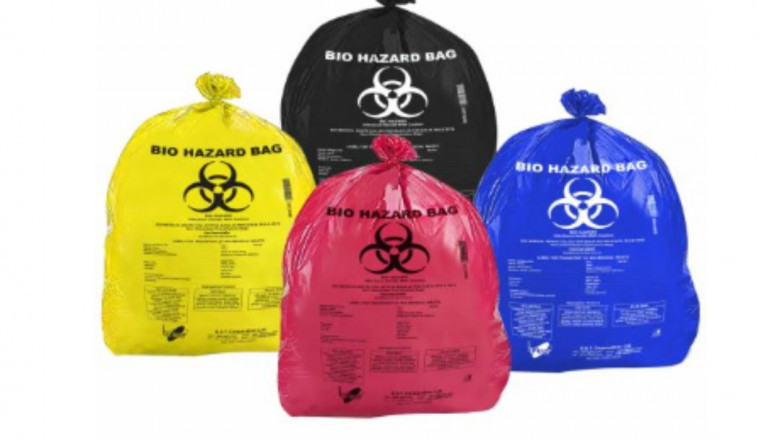views
Introduction
Proper handling and disposal of medical waste are critical for preventing infections and ensuring a safe healthcare environment. A biohazard bag is specially designed to contain potentially infectious waste materials, reducing the risk of contamination during storage, transportation, and disposal. Whether in hospitals, laboratories, or clinics, these bags play a central role in maintaining hygiene and regulatory compliance.
This article explores biohazard waste bags' features, types, uses, and importance and how they contribute to effective biomedical waste management.
What Is a Biohazard Bag?
A biohazard bag, also known as a bio-medical waste collection bag, is a specialized container made from durable, puncture-resistant plastic. It is designed to hold waste materials that pose a biological risk, such as used dressings, gloves, syringes, human tissues, blood-soaked items, and other clinical waste.
These bags are marked with the universal biohazard symbol and are typically color-coded based on the type of waste they are intended to collect, ensuring easy identification and safe segregation.
Why Are Biohazard Disposal Bags Important?
In medical and laboratory settings, improper waste management can lead to the spread of infectious diseases. Biohazard disposal bags are engineered to reduce this risk by:
-
Containing hazardous materials safely
-
Preventing leakage and spills
-
Aiding in waste categorization and segregation
-
Complying with biomedical waste disposal regulations
-
Reducing exposure to healthcare professionals and waste handlers
By using the right biohazard bag sizes and types, institutions can ensure better safety protocols and efficient waste handling systems.
Key Features of Biohazard Waste Bags
Here are the essential features that make these bags effective for biomedical waste management:
-
High-Density Plastic: Offers strength to hold sharps, liquids, and solids without tearing.
-
Leak-Proof Seams: Prevent fluid leakage and contamination.
Tear-Resistant Material: Minimizes the risk of puncture or rupture. -
Biohazard Symbol and Labels: Ensure immediate identification and caution.
-
Color Coding: Helps segregate waste according to biomedical waste guidelines.
-
Heat-Sealable or Tie Closures: Allows secure sealing to prevent spillage.
Common Biohazard Bag Sizes and Colors
Biohazard bag sizes vary depending on their use. Common sizes include:
-
Small (10–15 liters) – for light waste like swabs and gloves
-
Medium (20–40 liters) – used in outpatient departments and labs
-
Large (50–80+ liters) – for bulk medical waste in hospitals or operating rooms
Color coding is essential in biomedical waste segregation:
Proper adherence to these standards ensures safe and compliant waste disposal.
Types of Biohazard Bag
Depending on usage and facility requirements, biohazard bags come in several types:
-
Autoclavable Biohazard Bags
-
Withstand high temperatures for sterilization.
-
Ideal for labs and microbiology departments.
-
Infectious Waste Bags
-
Specifically designed for contaminated sharps and infectious materials.
-
Clinical Waste Bags
-
Used for non-sharp but infectious clinical waste like swabs and dressings.
-
Clear Biohazard Bags
-
Allow visual inspection of the contents for regulatory compliance or security
Each type ensures that waste is handled safely from the point of generation to disposal.
Applications of Biohazard Waste Bags
Biohazard waste bags are widely used in:
-
Hospitals and Clinics: For collection of surgical and post-surgical waste
-
Diagnostic Labs: To dispose of cultures, petri dishes, and sample residues
-
Research Facilities: For biological samples and experimental waste
-
Dental Clinics: To dispose of gloves, masks, and extracted materials
-
Veterinary Centers: For animal-related medical waste
-
Home Healthcare Settings: Especially where injections or dressings are involved
Guidelines for Safe Use
To ensure the safe handling of biohazard bags, follow these best practices:
-
Do Not Overfill – Leave enough room at the top for secure sealing.
-
Seal Properly – Use heat sealers or tie bands to prevent spills.
-
Use Appropriate Color Codes – Ensure correct waste segregation.
-
Store in Secondary Containers – Especially for large or leak-prone waste.
-
Label Clearly – If not pre-printed, include date, source, and contents.
-
Dispose of Regularly – Follow hospital or local biomedical waste guidelines.
These precautions help minimize contamination risks and maintain workplace safety.
Regulatory Compliance
Biohazard bags must comply with regional biomedical waste rules and environmental regulations. In India, for example, their use is mandated under the Bio-Medical Waste Management Rules issued by the Ministry of Environment, Forest and Climate Change.
Bags should be:
-
Approved by healthcare waste management authorities
-
Marked with the biohazard symbol and waste category
-
Manufactured using eco-friendly, non-chlorinated materials when possible
-
Disposed of via authorized waste management agencies
Benefits of Using Biohazard Waste Bags
-
Prevents Disease Spread: Limits cross-contamination and exposure risks
-
Ensures Workplace Safety: Protects staff, patients, and visitors
-
Supports Legal Compliance: Meets local and international waste disposal standards
-
Cost-Effective: Available in various sizes and types to suit all facility needs
-
Eco-Friendly Options: Some bags are biodegradable or recyclable
Investing in high-quality biohazard disposal bags not only ensures safety but also strengthens your facility’s environmental and health practices
Conclusion
A biohazard bag is more than just a waste cont






















Comments
0 comment